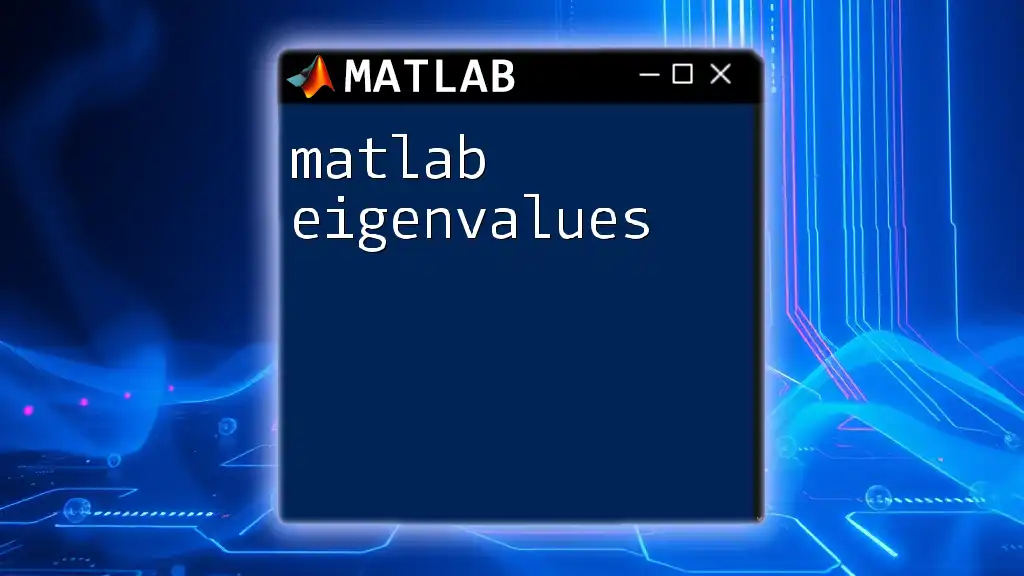The MATLAB exponential fit is a technique for modeling data by fitting an exponential function to a set of observed data points, allowing for predictions and analysis of growth or decay trends.
Here's a simple code snippet for performing an exponential fit in MATLAB:
% Example data
x = [1, 2, 3, 4, 5]; % Independent variable
y = [2.1, 3.9, 7.1, 13.4, 25.0]; % Dependent variable
% Exponential fitting
f = fit(x', y', 'exp1');
% Plotting the data and the fit
plot(f, x, y);
title('Exponential Fit');
xlabel('X-axis');
ylabel('Y-axis');
Understanding the Exponential Model
What is an Exponential Function?
An exponential function is a mathematical expression characterized by the form \( y = a \cdot e^{bx} \), where:
- \( y \) is the output of the function,
- \( a \) is a constant that affects the initial value of the function,
- \( b \) determines the rate of growth or decay,
- \( e \) is the base of the natural logarithm, approximately equal to 2.71828.
Exponential functions are distinctive because they either increase rapidly (growth) when the rate \( b \) is positive or decrease (decay) when \( b \) is negative. Understanding this relationship is crucial when choosing to fit your data to an exponential model.
When to Use Exponential Fitting
Exponential fitting is particularly useful when dealing with data that exhibits exponential trends. Common situations include:
- Population growth, such as bacteria reproduction, where populations grow proportionally to their current size.
- Radioactive decay, where the quantity of a substance decreases at a rate proportional to its current quantity.
- Financial models, like compound interest, where invested amounts grow exponentially over time.
Identifying these scenarios will guide you in employing the MATLAB exponential fit effectively.

Preparing Data for Fitting
Data Collection and Formatting
Quality data is the bedrock of any analysis. Collecting data should be done with attention to detail:
- Ensure that the data points are collected consistently over the same conditions to minimize biases.
- Clean the data to remove outliers or errors that may skew the fit. This includes checking for missing values and correcting inconsistencies.
Visualization of Data
Before fitting a model, visualizing the data is essential. It enables you to recognize patterns or trends and assess the suitability for exponential fitting. In MATLAB, you can create a scatter plot to analyze your data:
x = [1, 2, 3, 4, 5];
y = [2.7, 7.4, 20.1, 54.5, 149.5];
scatter(x, y, 'filled');
xlabel('x-axis');
ylabel('y-axis');
title('Data Visualization for Exponential Fit');
grid on;
This plot will give you a visual approximation to see if an exponential curve may fit well through the data points.

Performing Exponential Fitting in MATLAB
MATLAB Functions for Exponential Fitting
MATLAB provides several built-in functions to perform exponential fitting. The most commonly used include:
- `fit`: A robust function perfect for creating fitted models based on statistical methods.
- `mle`: Suitable for maximum likelihood estimation of parameters.
- `lsqcurvefit`: For nonlinear least squares optimization.
Step-by-Step Fitting Process
Step 1: Fit the Model
Using the `fit` function is a straightforward approach. This command allows you to specify the form of the exponential model you wish to apply:
fit_model = fit(x', y', 'exp1'); % 'exp1' indicates a single exponent
This fitting command creates a model of the form \( y = a \cdot e^{bx} \).
Step 2: Analyze the Fit
Once the model is fit, obtaining the fit coefficients and statistics is crucial for understanding your model:
coeffs = coeffvalues(fit_model);
This command will yield the values of \( a \) and \( b \) from your fitted model, which can provide significant insight into the nature of the data.
Step 3: Plotting the Fitted Curve
Visual representation is key to interpreting your model's effectiveness. Combine your data with the fitted model:
plot(fit_model, x, y);
xlabel('x-axis');
ylabel('y-axis');
title('Exponential Fit to Data');
legend('Data', 'Fitted Exponential Curve');
grid on;
This will generate a plot overlaying the fitted exponential curve on your data, allowing you to visually assess the fitting accuracy.
Evaluating the Fit
Understanding how well your model performs is vital. Evaluate the fit using metrics such as the R-squared value, which indicates how much variation in the data is explained by the model, and Root Mean Square Error (RMSE), which measures the average of the squares of the errors.
Residual analysis is also important; examining the differences between observed and predicted values helps ascertain the reliability of your model.

Advanced Techniques in Exponential Fitting
Using Nonlinear Least Squares
Sometimes, the data may require a more complex approach to achieve a better fit. Nonlinear least squares fitting can be conducted using the `lsqcurvefit` function:
modelFunc = @(b, x) b(1) * exp(b(2) * x);
b0 = [1, 1]; % Initial guess for parameters
bfit = lsqcurvefit(modelFunc, b0, x, y);
This feature allows you to define a custom model function and optimize parameters based on your initial estimates.
Model Comparison and Selection
After fitting different models, it is essential to compare their performances. The use of Akaike Information Criterion (AIC) can help you determine which model is more suitable. Models with lower AIC values provide better fit quality while considering the model complexity.
Troubleshooting Common Issues
Even experienced users may encounter challenges.
- Overfitting occurs when your model captures noise rather than the underlying data trends. Use parsimony as a guiding principle.
- Underfitting is when your model is too simple to capture the complexity of the data. It’s essential to strike the right balance to ensure an accurate model representation.

Conclusion
Exponential fitting is a powerful tool in data analysis, particularly when looking to describe phenomena that follow exponential trends. By mastering the MATLAB exponential fit, you can unveil insights and patterns within your data that may not be immediately obvious. With practice and by utilizing the techniques laid out, you can confidently apply exponential fitting in various real-world scenarios.

Additional Resources
For those looking to dive deeper into this topic, explore MATLAB's documentation and forums for community-driven support. Various online resources also provide excellent further reading on MATLAB's robust data fitting capabilities.

Call to Action
If you found this guide useful, consider subscribing for more insights on MATLAB commands and functionalities. Our upcoming workshops will also provide you with hands-on experience, guiding you to excel in your data analysis endeavors!

















